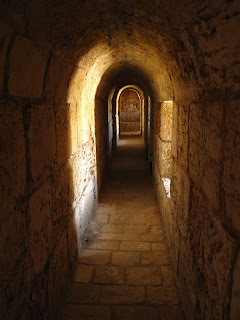I realize that the substance in this photo doesn't look all that exciting (as it turns out, brown syrup is extremely unphotogenic), but you have to trust me when I tell you that this sauce is the stuff dreams are made of. We first tasted the sauce at a local restaurant, where we ordered a platter of ten small salads, hummus, and dips that was served with fresh-baked bread. The majority of the platter was filled with things we had seen before, so we were initially thrown off by this ugly sauce that was completely unfamiliar. Once we tried it, though, we couldn't get enough. I was even tempted to ask for more so that we could eat it straight from the bowl. We dipped bread, vegetables, and even other sauces into it, noticing that each one had a better flavor with it than without. By the end of our meal, I knew I would have to learn to make the sauce at home. The server told us that the only ingredients were dates, honey, and tahini, so the next night I got out the food processor and proceeded to try my hand at the sauce. As is usually the case when trying to recreate restaurant food without a recipe, it didn't turn out great. Edible yes, but by no means magical.
Fast forward about a week, and I am on a tour of the Mehane Yehuda market. The guide leads us into a cramped shop selling all sorts of dried goods-- from beans and rice to nuts and spices-- and pulls from the shelf this jar of date syrup. He tells us about its incredible flavor and then it hits me: This is the missing ingredient from my magic sauce recipe! I bought a jar and remade the sauce, this time using the date syrup instead of blended whole dates. Where the previous sauce lacked a bold date flavor and deep color, this sauce had it all. I love kitchen triumphs.
I am not sure if you can find unsweetened date syrup in stores stateside, but it would be worth looking for it at your local health/natural food store just in case. The only ingredient should be dates, as seen in this syrup I found on Amazon: http://www.amazon.com/Date-Lady-Organic-Syrup/dp/B008EXLL4O
To make the sauce, simply combine 1/4 cup date syrup, 1/4 tahini, and 1 tablespoon honey in a bowl. Honestly, that's it. No special equipment required :) Use this as a dip for breads, mix into yogurt at breakfast, or even combine with more savory dishes for an amazing sweet-savory combination. Enjoy!


















































